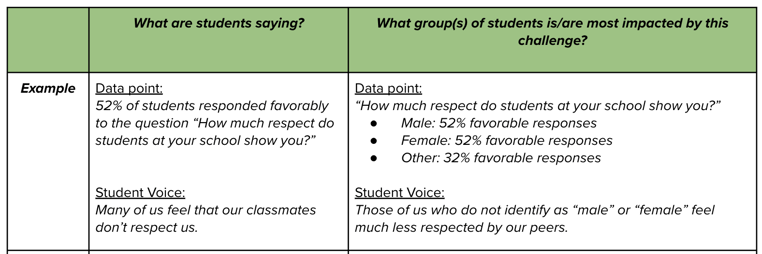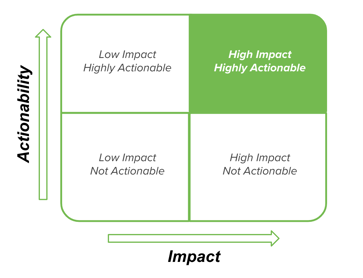Collecting and analyzing feedback from students on their learning experiences is a strategic priority for many districts. Our students’ perspectives have never been more critical to ensuring equitable and supportive learning environments.
However, sending out a student survey and understanding the responses is not enough. Caring adults must model the practice of moving from understanding to action. Students must know that their voices contribute to changing mindsets and shifting practices.
At Panorama, we've guided hundreds of districts through gathering, reviewing, and taking action on student voice data. In this article, we're drawing on a decade of experience to create a comprehensive guide to student voice. We've included discussion prompts for your student voice data planning meetings and models for boosting student agency.
Table of Contents
-
Discussion Prompts for Your Next Student Voice Planning Meeting
-
Empowering Students to Participate in Decision-Making Processes
|
Key Takeaways: Importance of Actionable Feedback: Merely collecting feedback through surveys is not sufficient. Schools and districts need to actively translate the insights from student feedback into meaningful changes. This involves understanding the data deeply and planning for implementation in areas that can have a significant impact on the learning environment. Engaging Students in Decision-Making: There are many ways to enhance student participation in school decisions. This includes reforming the student council to address major school issues, creating a Data Advisory Group that involves students in analyzing school data, including students in major committees, and organizing a Student Action Conference. These models aim to empower students and ensure their voices are integral in shaping their educational experiences. Using Data to Prioritize Actions: To handle the complexity of data from student feedback effectively, it can be helpful to focus on one or two high-impact areas that align with your district's priorities. This targeted approach helps ensure that the efforts are manageable and impactful, and that they involve the students most affected by these priorities. Building a Culture of Continuous Feedback: It's important to regularly review and respond to student feedback. This continuous loop helps build a supportive and responsive educational environment where student input leads to real-time improvements. |
Discussion Prompts for Your Next Student Voice Planning Meeting
I. Preparing to Review Student Voice Data
Reflecting on student voice data can often be challenging or uncomfortable. Before diving into the data, share your aspirations and apprehensions to set the stage for a productive discussion about using student feedback. In addition, take a moment to anticipate what you expect to see in the data.
- What aspirations do you have about using student data?
- What apprehensions do you have about examining student data?
- What areas of strength do you expect students will identify?
- What areas of improvement do you expect students will identify?
- What are you most curious to know from the feedback?
- What changes do you expect to see if you have feedback from previous surveys?
As you prepare to review the data, take a moment to familiarize yourself with the ladder of inference. Popularized by Peter Senge's The Fifth Discipline, the ladder of inference is a mental model for reducing bias while understanding and analyzing data. The key is to climb slowly up the ladder of inference, spending more time observing the data. Then, consider alternative explanations in the data before deciding what it means and choosing a course of action.
II. Reflecting on Student Voice Data
Now that your team has prepared to engage with the data, it's time to review the survey results. Consider the data points that most jump out at you, and listen for the narrative behind the numbers. As you take your first pass through the results, remember to stay low on the ladder of inference.
- What did students identify as your district's biggest strengths?
- What did students identify as your biggest areas for growth in the district?
- What notable differences did you see in student experience based on student background?
- What made you most proud?
- What connections can you make between the data from this survey and other data you have related to your practice?
- What biases may exist as you interpret the data?
It's crucial to center conversations about student voice data in equity. For example, if your team starts with the question:“What are the key challenges we want to prioritize as a district?” Follow that by asking: “Which students are impacted by this challenge?”
As you disaggregate your data by race, gender, FRPL status, ELL status, and grade level, structure your data inquiry protocols to emphasize that crucial question.

III. Prioritizing and Synthesizing the Data
When dealing with a rich data set, prioritization is key. Select one topic (or two, at most) to prioritize. Consider focus areas that are high-impact and highly actionable, as pictured in the matrix below.

- Based on the data, what focus area would yield the greatest impact for students?
- Is this focus area aligned to school priorities?
- Who is impacted by the decision to focus on this priority?
- How will we ensure the inclusion of students most impacted by this priority area in the design of our next steps?
IV. Planning Your Path Towards Improvement
Finish out the data exploration process by creating a rollout plan for your district or school. This is your chance to think through logistics and consider the steps you'll take to implement your focus area.
- What will you prioritize or focus on for this or next year?
- Why will this be the most impactful thing to focus on?
- When is the ideal time to introduce this work to your team? Where is the appropriate setting?
- What are some challenges you may face in the process?
- How will you break down your goal into steps?
- How will you hold yourself and your team accountable to action? (What calendar invites do you need to send? What PLCs do you need to set up?)
Empowering Students to Participate in Decision-Making Processes
Developing strong data exploration processes is key to taking action on student voice data. But it's equally important to incorporate students into that process. Students can help proctor surveys, participate in data advisory groups, and sit on school committees. Here are four models for how schools can empower students to participate in decision-making to improve school culture.
1. Reframe the mission of student council
Use these approaches to reorient the purpose of student council to launching big projects and solving problems:
- Engage the whole school to help set priorities. Student leaders create a list of the top five issues at school. During advisory or homeroom, ask students across campus to vote on the two issues they think are most important to address this semester. The student council makes action plans to address the top issues.
- Involve the whole school in tackling major issues. Student leaders spread out across the school with guiding questions around a tough school issue (e.g., bullying) and how to solve it. Student leaders draw conclusions from their fellow students’ perspectives and suggestions and create action plans.
- Manage the survey process. Empower the student council to proctor the student feedback survey. They can explain the purpose of the survey, read out instructions to their peers, and field questions.
2. Share data with students about what’s happening at school
Convene a new student leadership group at your school: the Data Advisory Group. This group can meet regularly to review and understand school data and reveal successes and important areas for improvement. Students participating in this committee can build math, statistics, and coding skills by looking at school data. Ask the group to make recommendations to the principal, who will then report back on actions taken.
3. Involve a student in every major decision
In California, the State Board of Education includes one student serving a one-year term. The student is a first-class member of the board, casting votes on everything from textbook selection to English learner programs. Take a page from the state’s playbook by putting a student on every major committee and involving them in big decisions at the school.
Truly consulting with students and inviting them to sit on school committees with a full seat at the table can win respect from the student body and send an important signal to everyone that it’s important to listen to students’ perspectives.
4. Convene a student action conference
Want to really take student voice to the next level? Block off a Saturday and invite students to participate in a “Student Action Conference.” Have students identify and prioritize areas for improvement at the school and propose solutions for each area. Consider focusing on promoting college opportunities, increasing course rigor, building better awareness of career possibilities, and improving student health and nutrition.
|
Frequently Asked Questions How can we effectively train our staff to interpret and act on student voice data? District leaders can provide professional development workshops, seminars, or online courses specifically focused on interpreting and utilizing student feedback data. Additionally, mentoring or coaching programs where experienced educators guide others in this process can be valuable. Collaborative learning communities within and across schools can also facilitate knowledge sharing and best practices. How can we measure the impact of changes made based on student feedback? Districts can employ a variety of methods to assess the impact of interventions, such as tracking changes in academic performance, attendance rates, discipline incidents, and student satisfaction surveys over time. Comparative analysis of before-and-after data can provide insights into the effectiveness of initiatives. Qualitative methods like focus groups or interviews with students can also capture nuanced feedback on the impact of changes. How can we ensure consistent student participation in feedback initiatives across all schools in the district? District leaders can implement strategies such as standardized survey administration protocols, regular communication about the importance of student feedback, and incentives for participation (e.g., recognition, rewards, or extra credit). Engaging student leaders in the planning and promotion of feedback initiatives can also increase buy-in and participation rates. Additionally, leveraging technology to make surveys accessible and convenient for students, such as mobile-friendly platforms or in-class survey sessions, can help boost participation. Regular monitoring and feedback loops to adjust strategies based on participation trends are also critical. |
Next Steps for School and District Teams
Our students’ perspectives have never been more critical to ensuring equitable and supportive school cultures. Asking questions and understanding responses is not enough. We firmly believe that data is only as valuable as it is actionable. A stronger understanding of any data allows for stronger, more relevant action.
By measuring student perceptions, the Panorama Student Survey gathers feedback from students about their classroom experience. Decades of research have shown that student perceptions strongly correlate with learning outcomes and can be an important improvement tool for school systems.
Download Panorama's complete Student Survey to elevate student voice







.webp?width=478&height=557&name=panorama_student_survey-1%20(1).webp)